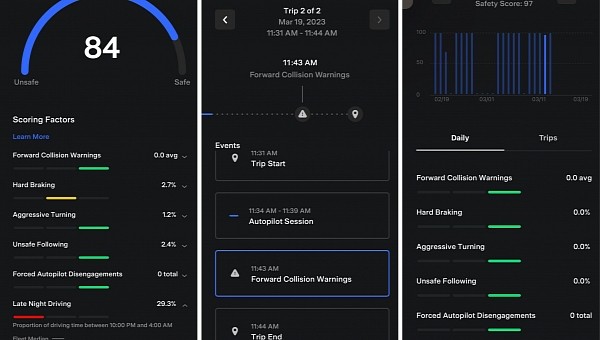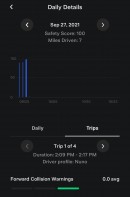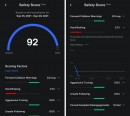Tesla said it created its insurance arm to help owners pay less than third-party insurers charged them. Still, owners complain that the criteria used to evaluate their driving behavior, and especially the Tesla Safety Score, is flawed.
Tesla initially devised Safety Score as an algorithm to gauge insurance premiums to drivers. Akin to the telemetry data used by other insurance companies, Tesla Safety Score taps into the vehicle data to assess driving behavior. Later, Tesla reshuffled Safety Score to determine which drivers were suitable to access the FSD Beta program. This has led to awkward situations, with Tesla drivers trying to maximize their scores to get access to the program.
Safety Score has evolved since then to fulfill its role as an evaluation tool. In November last year, Tesla revamped the software, introducing controversial new criteria. The most contested was probably the "late night driving," which penalizes drivers that drive between 10 pm and 4 am. Tesla claims it has introduced this criterion because studies show that many accidents happen during this interval.
Driving at night is inherently more dangerous, but 10 pm is considered by many as too restrictive, considering that people often drive home at that time. Besides, Tesla incentivizes drivers to charge their cars after 10 pm to benefit from the cheapest Supercharger rates. What about being a designated driver for friends at a party? God forbid, your insurance premium will go through the roof.
Of course, driving time is not the only criterion, but it is one of the most important. Other factors considered are aggressive braking and hard turning, unsafe following distance, forward collision warning, and Autopilot disengagements. Although they seem to be enough to assess drivers' behavior, Tesla owners claim this is not true. Many say that the Safety Score should not be based so much on how others drive as the late-night driving criterion appears to be.
The other criteria are no better, thanks to Tesla's safety assist systems' erratic behavior. The Forward Collision Warning system is known to give false alerts, and these hiccups will affect the Safety Score. Many Tesla owners report they frequently encounter false alerts, and there's no way to dispute or submit them for review.
Since Teslas are also known for their phantom braking, that's another thing affecting the Safety Score. These factors outside drivers' control should not count toward the insurance premiums. Unsafe following is a good criterion, but Tesla doesn't say what a safe following distance should look like. There's no warning, so drivers have no feedback when this is triggered.
With access to so much data from its cars, Tesla is probably better positioned than any other insurance company to know exactly how its drivers behave behind the wheel. And yet, it chooses to resort to half-baked solutions that annoy owners rather than help them. No wonder some have sued the company for this blunder.
Safety Score has evolved since then to fulfill its role as an evaluation tool. In November last year, Tesla revamped the software, introducing controversial new criteria. The most contested was probably the "late night driving," which penalizes drivers that drive between 10 pm and 4 am. Tesla claims it has introduced this criterion because studies show that many accidents happen during this interval.
Driving at night is inherently more dangerous, but 10 pm is considered by many as too restrictive, considering that people often drive home at that time. Besides, Tesla incentivizes drivers to charge their cars after 10 pm to benefit from the cheapest Supercharger rates. What about being a designated driver for friends at a party? God forbid, your insurance premium will go through the roof.
Of course, driving time is not the only criterion, but it is one of the most important. Other factors considered are aggressive braking and hard turning, unsafe following distance, forward collision warning, and Autopilot disengagements. Although they seem to be enough to assess drivers' behavior, Tesla owners claim this is not true. Many say that the Safety Score should not be based so much on how others drive as the late-night driving criterion appears to be.
The other criteria are no better, thanks to Tesla's safety assist systems' erratic behavior. The Forward Collision Warning system is known to give false alerts, and these hiccups will affect the Safety Score. Many Tesla owners report they frequently encounter false alerts, and there's no way to dispute or submit them for review.
Since Teslas are also known for their phantom braking, that's another thing affecting the Safety Score. These factors outside drivers' control should not count toward the insurance premiums. Unsafe following is a good criterion, but Tesla doesn't say what a safe following distance should look like. There's no warning, so drivers have no feedback when this is triggered.
With access to so much data from its cars, Tesla is probably better positioned than any other insurance company to know exactly how its drivers behave behind the wheel. And yet, it chooses to resort to half-baked solutions that annoy owners rather than help them. No wonder some have sued the company for this blunder.
Unsafe Following: There is no indication as to what a “safe distance” to keep between cars is in Tesla’s eyes. There should be a warning you can enable on the screen that tells you if and when you are following too close to the car in front.
— Peter (@peatoe_) March 17, 2023






